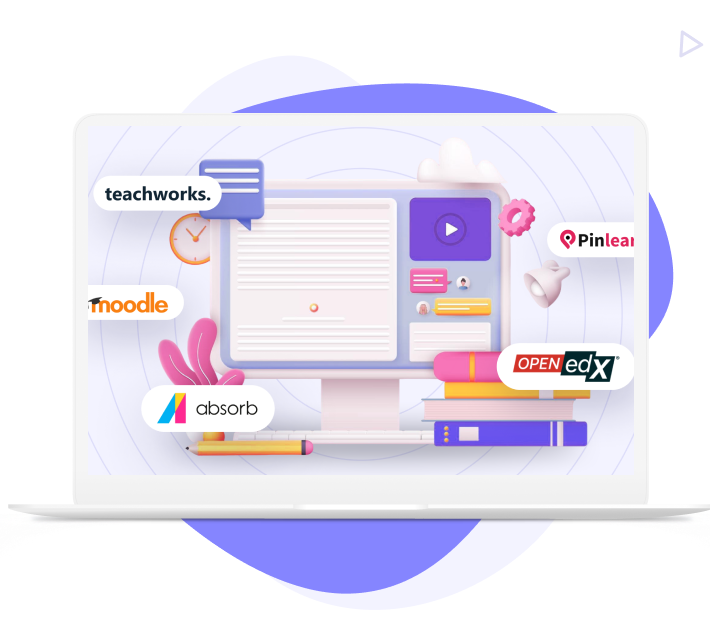A learning management system (LMS) migration is a business-critical process, not just a technical refresh. It affects productivity, regulations, training outcomes, and even customer satisfaction. Whether your goal is to reduce costs or meet evolving regulations, executive involvement is crucial from the start.
The LMS market continues to grow rapidly. It’s projected to reach $82 billion by 2032 with a 17.1% CAGR. Yet nearly half of organizations lack a clear migration strategy or ROI framework, putting their investment, operations, and users at risk.
Poorly managed migration can lead to data loss and security risks. It can disrupt key integrations, delay onboarding, compromise compliance, and consume budget through retraining, downtime, and missed content transfers.
Key takeaways
- An effective LMS migration is a business undertaking, not an IT project.
- Approximately 50% of all organizations embark on a migration without a clear plan.
- The greatest danger isn’t technical failure, but user poor adoption.
- Multi-phase rollouts reduce risks more effectively than a one-time “big bang” launch.
Whether your team is already planning an LMS switch or building a blueprint to defend operations, user experience, and long-term ROI, this guide will help you to do it right.
Why LMS migration is a strategic business move
An LMS is no longer just a technology tool. It’s an essential way for corporations to increase retention and monitor performance. When legacy systems slow learning, frustrate teams, and hinder strategic objectives, migration is no longer merely an IT challenge. It becomes a business priority.
Design that fuels learner engagement
A very bad UX can be a leading cause of migration. Today, people want an easy experience. When your LMS is a burden to use, the engagement will drop. A friendly design is not an option but a necessity as it makes the training process feel easy and welcoming.
UX designer Lewis Carr once reimagined Moodle with a Netflix-style layout, featuring sleek course tiles, personalized dashboards, and an intuitive interface. Learners can now “binge” content the same way they watch shows, resuming exactly where they left off. While this wasn’t a full LMS migration, it highlights how robust design alone can dramatically boost engagement and completion rates.
Strategic execution
Moving to new software should be well planned to prevent data loss and downtime. Effective project management, communication, and strategies are the keys to success. Ensure you have a step-by-step process, data audits, user training, and a rollback plan to reduce the impacts.
Baptist Health moved 17,000 users to Saba Cloud in just 4 months, aligning it with their Workday HRIS rollout. The key? Good leadership, planning, and governing. The outcome: no downtime, full compliance, and an enhanced learning experience.
Migration as a growth lever
Done right, LMS migration is a chance to reimagine learning from the ground up. With mobile-optimized dashboards, smart autoplay, interactive polling, and intuitive content discovery, a new platform can transform the way employees learn and engage.
Nowadays, upgrading your LMS isn’t optional. It is the foundation of a high-performance, scalable learning culture that grows in tandem with your company.
Common pitfalls in LMS migration (and how to avoid them)
Even the most robust migration strategies can fail if teams underestimate the challenges of switching platforms. The majority of failures don’t stem from ineffective planning, but from the inability to identify critical project risks early enough.
Find potential problems early to prevent costly delays. Below are the most common mistakes during LMS migration, along with methods to avoid them.
1. Incomplete data mapping
One of the main causes of LMS migration issues is misaligned course structures, user roles, or historical training records. If learning paths, certification rules, or metadata don’t align with the new system, automation breaks down, and users get lost in the process.
Solution: Create a comprehensive data mapping plan before you begin any data migration. Compare how your legacy and target LMS handle permissions, course structures, assessments, and reports. Run test migrations in a staging environment to detect inconsistencies early and ensure clean data transfer before learners log in.
2. Underestimating user adoption
Don’t assume users will embrace the new LMS easily. Change can be a source of friction, especially among teams accustomed to old workflows or manual processes that no longer fit.
Solution: Turn onboarding into the central element of your LMS migration plan. Offer live demos, microlearning modules to showcase major LMS features, and get “power users” to act as internal advocates. Segment your users by roles and tailor onboarding content accordingly. Adoption happens not by default, but through focused training and peer support.
3. There is no one-size-fits-all strategy to migration
A generic strategy rarely works. Particularly, for large organizations with complex departments, strict compliance rules, or global teams. What succeeds for a 200-person sales unit may fail in an enterprise of 5,000 users.
Solution: Align your mobility plan with your company’s complexity, pace, and risk tolerance. The phased rollout allows you to test functionality, gather customer feedback, and refine the process until the final release. For smaller teams or agile setups, an all-at-once launch might be more effective. Select an approach that best suits your business architecture, rather than one that seems the simplest.
4. Neglected post-migration support
Many LMS migrations focus heavily on pre-launch preparation but pay little attention to what happens after go-live. If users face bugs, lack access to content, or experience issues with the navigation system, the new LMS may not get a second chance to prove its value.
Solution: Offer dedicated assistance for at least 30-60 days after the migration. Use a help desk, live chat, or internal champions to resolve issues quickly. Track usage metrics daily to spot drop-offs, error spikes, or incomplete learning paths, and respond fast to maintain momentum.
5. Skipping real-world testing leads to go-live failure
Such features as SCORM playback, assessment scoring, or SSO logins tend to fail after launch, not due to fault code, but from isolated testing.
Solution: Develop test scenarios that cover all important processes across devices, browsers, and user types. Conduct a pilot with actual learners, not just internal administrators. Test third-party integrations such as your HRIS, CRM, or authentication systems in a production-like environment. Don’t launch until every essential function runs reliably.

Related article
Learning management system comparison: Finding the platform for your training needs
Exploring more LMS platforms? If you’re still benchmarking solutions, check out our in-depth breakdown of additional LMS platforms and ecosystem capabilities to support scalable learning strategies.
Compare more LMS optionsThe critical phases of a successful LMS migration
Migrating to a new LMS platform entails a significantly different approach to enabling, managing, and measuring learning within your organization. The impact is broad: business continuity, compliance, and learner experience all depend on how well the LMS migration goes. Below are the main migration processes, with some practical advice to guide you through a non-disruptive and low-risk transition.
1. Discovery & audit
Before taking any action, assess your current system: what you already have, what you can migrate, and what to leave behind. It goes to content type, integrations, user roles, and technical dependencies.
Document content types: SCORM, xAPI, quizzes, videos, discussion boards, attachments.
Document active integrations: SIS, HRIS, SSO, video tools, and analytics levels.
Flag items that won’t migrate: outdated plugins, hard-coded elements, or legacy custom tools.
Pro tip: Utilize automated crawlers to discover deeply linked content and undocumented API calls. They often break silently during migration if missed.
2. Define requirements for the new LMS
It is essential to have a clear understanding of your organization's technical, functional, and compliance requirements before selecting or deploying a new LMS.
Features like SSO and SCORM support are essential, while gamification or AI-based recommendations are nice-to-have additions.
Verify compliance needs: by auditing trajectories, data residency, and accessibility levels.
Define requirements in terms of interoperability: access by API, compatibility with LTI, support of SCORM or xAPI.
Pro tip: Ensure that you don't simply migrate your old LMS, but strive to create an enhanced learning experience that is also scalable in the long term.
3. Create a parallel environment
Avoid risky “big bang” cutovers. Instead, build a fully functional staging environment that mirrors real user behavior and configurations.
Set up a sandbox with real course data, roles, and permissions.
Replicate production settings to simulate real-world usage.
Run pilot tests with real learners and instructors to collect feedback.
Pro tip: Let select teams test the new LMS first — early validation reduces bugs and boosts user buy-in.
4. Schedule and phased cutover
Time matters. Therefore, to minimize disruption, schedule your cutover during natural learning calendar breaks.
Align migration with semester breaks or training downtimes.
Begin with low-risk departments or archived content.
Keep rollback access to the old LMS during the initial phase.
Pro tip: Communicate proactively. Inform learners and stakeholders about upcoming changes and the necessary actions they should take.
5. Use data migration tools with delta sync
Manual data transfers can cause errors and lost records. Migrate user data, courses, and progress using specialised LMS migration tools and maintain consistency.
Use official tooling, such as Moodle CLI, Canvas API, or Blackboard REST API.
Apply delta sync to transfer only new or updated records during later phases.
Automate user creation and enrollment mapping.
Pro tip: Always validate imported data against the original source to prevent corruption or loss.
6. Validate everything twice
After importing data, verify every element, not just with tools but also with people who understand learning workflows.
Check file integrity using checksums.
Manually review critical items: assessments, certifications, discussion boards, transcripts.
Confirm that analytics dashboards and SSO function smoothly across devices.
Pro tip: Run a full test course with a pilot group to gather feedback on content accuracy, usability, and overall experience.
7. Monitor system health and user behavior
After going live, active monitoring becomes essential. Login loops, broken links, or slow load times may easily break a user's trust.
Monitor system performance using APM tools and real-time dashboards.
Track key metrics, including the rate of logins, loading time, SCORM completions, and page errors.
Set alerts to catch anomalies and broken interactions immediately.
Pro tip: Reviews user complaints, helpdesk tickets, and in-app comments to find underlying issues and solve them as soon as possible.
8. Run training and support blitz
Even the best LMS can fail without proper training. Users need guidance on how to use the new interface, utilize its features, and diagnose incorrect functions and problems.
Offer situational assistance such as tooltips, pop-up boxes, and internal FAQ pages.
Assign internal champions in every department to provide fast local support.
Offer live chat or a helpdesk during the first 4-6 weeks.
Pro tip: Track recurring issues and update your documentation or onboarding instructions to refer to these issues.
9. Archive legacy LMS and set retention policies
Archive the legacy LMS after a successful cutover.
Lock down access after a defined grace period (60-90 days).
Export sensitive information, such as grade books, certifications, and audit trails.
Encrypt archived information, define deletion and retention rules for a long-term period.
Pro tip: Do NOT delete anything until your compliance team confirms that the archival process is in line with the regulatory and audit requirements.
Technical checklist for a frictionless LMS migration
Besides moving content, the LMS migration requires thorough verification of infrastructure, security, compatibility, and compliance. Use this checklist to cover all technical essentials and ensure a smooth transition from your old LMS to the new one.
1. Mapping of permissions and roles
Various LMS platforms have different roles and access management. Ineffective mapping can disrupt work processes, restrict access to content, or create security issues.
Compare role levels in both the old and new LMS.
Map permission for instructors, admins, learners, and guests.
Double-check admin privileges to prevent granting excessive or insufficient access.
2. SCORM, xAPI, and LTI compatibility validation
Course content must run flawlessly on the new platform. Compatibility issues with learning standards can render valuable assets unusable.
Verify that SCORM 1.2/2004 and xAPI files launch and track correctly.
Validate all LTI tools, such as external resources, assessments, and proctoring services.
Test completions to ensure accurate progress tracking and score reporting.
3. API endpoints and integrations
Improperly mapped or outdated APIs can break LMS integrations if. This affects HR syncs, user provisioning, reporting, and access to third-party content.
Audit all existing integrations, such as HRIS, CRM, SIS, and content libraries.
Reconfigure endpoints, tokens, and permits with the new LMS provider.
Confirm real-time sync or batch update schedules function as expected.
4. Authentication and SSO configuration
After migration, authentication issues can quickly frustrate learners and admins..
Ensure compatibility with SSO models, SAML, OAuth, and LDAP.
Verify multi-factor authentication/role-based access controls.
Test login operations across browsers, smartphones, and tablets to facilitate easy access.
5. Load testing and performance benchmarks
Skipping performance validation can cause bottlenecks once your new LMS is in real-world use.
Simulate peak loads like concurrent logins, video streaming, and test completions.
Benchmark critical metrics: load times, failure rates, and API response speeds.
Run load tests on both frontend and backend systems to ensure smooth operation.
6. Mobile compatibility testing
Mobile accessibility is important because otherwise, learners will encounter issues with mobile devices.
Check UI and UX on Apple iOS, Android, and tablets.
Ensure responsive layouts for all course formats and dashboards.
Verify that SCORM packages and quiz attempts work smoothly on mobile platforms.
7. Accessibility checks (WCAG compliance)
Non-compliant systems risk legal and reputational damage. Validate compliance before go-live.
Audit the new LMS against WCAG 2.1 AA standards
Test screen reader support, keyboard navigation, and color contrast.
Ensure that videos, PDFs, and slide decks have accessible versions.
8. Data retention policies and alignment
Data compliance breaches during LMS data migration can lead to costly regulatory penalties. Validate policies upfront, not after an audit.
Confirm data storage locations and applicable jurisdictions.
Ensure handling of personally identifiable information (PII) meets GDPR and HIPAA requirements.
Define clear data retention and deletion workflows aligned with regulations.
Metrics to measure migration performance
LMS migration success doesn’t end once the last course is uploaded. Organizations must monitor key performance indicators (KPIs) to measure impact and identify areas for improvement. These metrics extend beyond uptime, measuring real business results, learners’ engagement, and overall satisfaction with the new system.
Planned vs. actual: downtime
Unplanned outage harms trust and productivity.
Track actual downtime against planned cutover windows.
Flag delays caused by data-sync errors, API failures, or performance bottlenecks.
Identify ripple effects across departments or regions.
A minimal gap between expected and actual downtime signals an easy migration and a reliable system launch.
Percentage of successfully migrated & functional courses
Not all assets migrate smoothly. Broken SCORM packages, missing quizzes, or outdated links can disrupt the learning experience.
Calculate the percentage of courses migrated without errors.
Audit course structure, media, completion logic, and grading rules.
Validate learning paths and prerequisites in the new LMS.
This metric directly impacts learner readiness and speeds time-to-productivity on the new platform.
User login rate within the first 7 days
Adoption speed reveals learner engagement and buy-in.
Monitor how many users log in during the first week after migration
Compare engagement rates across departments, cohorts, or regions
Segment data to identify friction points like mobile UX issues or SSO errors
Low login rates often signal problems in training, communication, or user experience.
Support tickets opened per user group
Help-desk spikes highlight system issues and knowledge gaps.
Track ticket volume by user type: admins, instructors, learners.
Categorize top problems: login errors, content issues, navigation confusion.
Use dashboards or heatmaps to pinpoint where support is most needed.
Proactive support during the first 30 days is critical to maintaining user satisfaction after migration.
Training completion rate before vs. after migration
Training links the legacy LMS to the new learning experience.
Compare the percentage of completion rates required for modules before and after migration.
Identify drop-offs or improvements tied to interface changes, content layout, or device usage.
Gather user feedback through surveys to measure ease of use and content clarity.
Tracking these changes reveals whether your new LMS enhances or hinders learning outcomes.
Questions to align your teams before LMS migration
A smooth LMS migration process requires full alignment across IT, L&D, compliance, and support teams. The biggest risks don’t come from technical issues but from poor communication, unclear ownership, and unchecked assumptions. Use these questions to uncover blind spots before they disrupt your migration plan.
Do we fully understand the core reasons for migration, and are we aligned on clear requirements?
Treat this as your alignment checkpoint. Before migrating any data or configuring the new platform, the entire team needs clarity and agreement on why the change is happening:
Is the goal to scale more efficiently, improve user experience, reduce costs, or meet compliance standards?
Have all departments agreed on what success looks like?
Are the LMS requirements clearly documented, approved, and ready for implementation?
Without this shared foundation, even a technically flawless migration can fall short and fail to deliver business value.
Do we have a complete backup and rollback plan?
Even with the best preparation, LMS migrations can go off-script. A solid fallback plan protects against surprises:
Have you backed up all key data from the old LMS (courses, user enrollments, activity logs, and configurations)?
Is there a tested rollback strategy in place if something fails during the cutover?
Have you defined clear rollback triggers and response timelines?
Treat this as essential insurance, not a secondary concern. Avoid data loss or prolonged downtime.
Have we tested user access flows end-to-end in staging?
Migrating content alone isn’t enough. Learners must easily access it.
Can users log in through all expected channels (SSO, email, mobile)?
Have instructor and admin roles been fully verified with correct permissions?
Have you confirmed intuitive learner experiences across desktop, mobile, and tablet?
Ensuring easy access is the foundation for a successful LMS transition.
What’s our fallback if authentication or SSO fails?
If SSO fails on day one, learners won’t wait. They’ll abandon the platform.
Have you set up alternative login options?
Can accounts be manually recovered during emergencies?
Is your LMS administrator ready with a clear communication plan?
Downtime here affects not only productivity but also user trust.
Are our 3rd-party tools and data sources reintegrated and validated?
An LMS system is only as strong as its connected ecosystem.
Have you reconnected video conferencing, content libraries, CRM, and HRIS tools?
Are all integrations tested with live data?
Have you monitored webhook and API triggers for expected behavior?
When data stops flowing, the learning experience grinds to a halt.
Who owns post-migration support and monitoring?
Gaps in ownership often derail migrations after they are launched.
Who monitors uptime, error logs, and user feedback during the first 30 days?
Who manages help desk escalations?
Is the migration team still involved after launch, or has responsibility shifted to operations?
A clear role definition ensures accountability and keeps your LMS migration on track after the go-live date.
Conclusion
A successful LMS migration doesn’t happen by chance. It requires meticulous planning, technical precision, clear communication, and strong support well beyond go-live.
The key to success is simple but essential:
A detailed migration plan aligned across all teams
Technical readiness with thoroughly tested integrations
Low risk and phased deployment, including aftercare inspection around the clock
After migration support, it will mature based on the feedback of the user and real usage
LMS migration is an opportunity to transform learning into a performance, retention, and growth driver. This can improve the learning experience by providing better analytics and easier compliance.
Are you ready to migrate with less pain and the most value? Let Geniusee guide your team from audit through post-launch success. Contact our LMS experts today to start building your migration strategy!





















